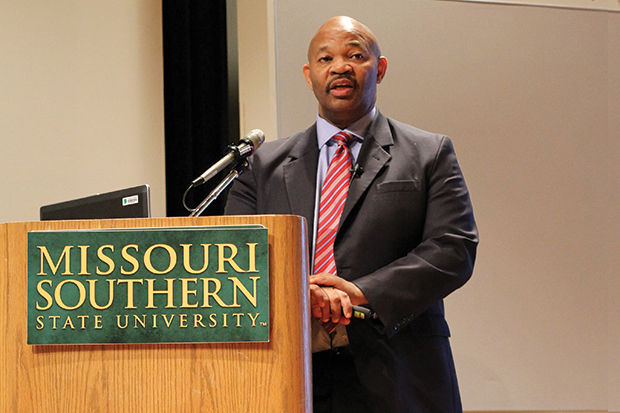Monarchs impact culture of pro baseball
Phil S. Dixon, co-founder of the Negro League Baseball Museum located in Kansas City, Mo., gave a presentation to Southern students in Corley Auditorium on Wednesday, January 21.
Few people realize the true impact African-Americans had on the game of baseball before Jackie Robinson made his way into the limelight with the Brooklyn Dodgers. Phil S. Dixon, however, has spent most of his adult life researching and recording the history of baseball’s Negro Leagues, especially the impact the Kansas City Monarchs had on both the game of baseball and race relations in the United States.
Dixon visited Missouri Southern on Jan. 21, giving two presentations about the Kansas City Monarchs and how they blazed trails in professional sports. The Monarchs had a heavy influence on not only the game of baseball on a national level, but also in the four states area, where they played in Joplin, Springfield and a number of other surrounding towns.
According to Dixon, the Monarchs were formed in 1920, beginning the path to a “baseball revolution,” as he called it.
“There is no team in baseball that did more than the Kansas City Monarchs to create good race relations,” said Dixon. “They have a very interesting history.”
The Monarchs won their first Negro World Series in 1924 behind the arm and bat of Wilber “Bullet” Rogan – a player Dixon regards as possibly the most talented all-around player ever because of his rare ability to pitch and hit at the highest level.
Because of their early success, the Monarchs became a breeding ground for young baseball talent. This would go on to bolster the Monarchs’ reputation in the early 40s when baseball became integrated.
Dixon noted that owner J.L. Wilkinson was the only white owner when the Negro Leagues were formed. In Dixon’s mind, Wilkinson did as much for race relations in baseball as anyone.
“In 1911, he created a team called the All-Nations, and it was the first time that many nationalities had played on the same team,” said Dixon.
Former players said Wilkinson was the only person they ever met without an ounce of prejudice in his body, according to Dixon.
Throughout the presentation, Dixon provided examples of memorable feats that could be traced back to the Monarchs. One of the biggest examples of this is Jackie Robinson, who played his final season in the Negro Leagues for the Monarchs before going on to be the first African-American to play for a major league team.
Another Hall of Famer, Satchel Paige, spent a considerable amount of time playing for the Monarchs. Paige holds the record for playing in a game at the oldest age, suiting up for the Athletics at the age of 59. Paige also became the first player entered into the Hall of Fame primarily as a Negro Leaguer.
Ernie Banks, who spent time with the Monarchs very early in his career, went on to become the first African-American to win multiple Most Valuable Player awards. He also belongs to the esteemed “500 Club,” which is made up of players with 500 career home runs.
Dixon works as an author and was a co-founder of the Negro Leagues Baseball Museum in Kansas City. He is recognized as an outstanding baseball historian. Currently, Dixon is embarking on a tour of 90 cities as an ode to the 90th anniversary of the Monarchs first championship.
Your donation will support the student journalists of Missouri Southern State University. Your contribution will allow us to purchase equipment and cover our annual website hosting costs.




























